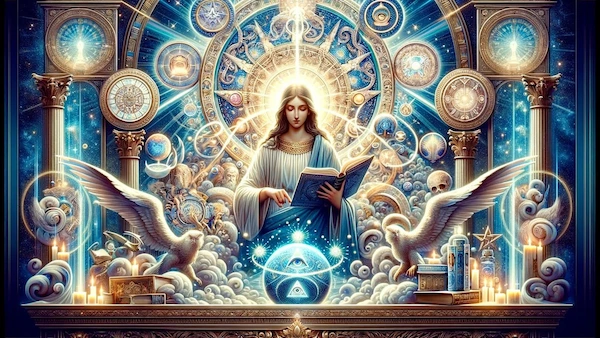
The Celestial Drama of Gnosis
The Pistis Sophia stands as one of the most enigmatic and profound texts within the Gnostic tradition—a spiritual symphony composed of multiple movements, each revealing deeper layers of esoteric wisdom. Unlike conventional religious texts that offer straightforward narratives or commandments, this remarkable work unfolds as a cosmic drama centered on Sophia, the embodiment of divine wisdom who descends into the chaotic realms of materiality. Her journey—from celestial heights to the depths of darkness and back again—serves as an allegory for the soul’s own odyssey through existence.
The very title of this work carries significant philosophical weight: “Pistis” (faith) joined with “Sophia” (wisdom) creates a compelling dialectic between belief and knowledge that runs throughout the text. This tension—between what one trusts through intuition and what one knows through direct experience—forms the philosophical cornerstone of Gnostic thought itself. Unlike exoteric religious traditions that often emphasize faith in external authority, the Pistis Sophia presents a path of illumination through inner knowing.
Within its layered narratives, the text reveals itself as far more than mere mythology. It constructs an intricate cosmological framework where metaphysics, ontology, and epistemology intertwine, offering a comprehensive vision of reality that challenges conventional understandings of divinity, consciousness, and salvation. The dialogues between the risen Christ and his disciples—particularly with Mary Magdalene, who emerges as a profound questioner and wisdom-bearer—provide a pedagogical structure through which these complex teachings unfold.
The Cosmological Architecture
The Pistis Sophia presents a vast cosmological architecture that extends far beyond the simplified heaven-earth dichotomy found in conventional religious thought. At its summit resides the ineffable, unknowable source—the Absolute beyond all conceptualization. From this primordial ground of being emanate successive levels of divine manifestation known as aeons, each representing particular aspects of divine consciousness.
These aeons collectively form the Pleroma—the fullness of divine reality characterized by harmony, light, and perfection. This realm exists beyond conventional notions of time and space, representing the true spiritual homeland from which all souls originate. The text describes this realm as “the Treasury of Light” where “there is neither male nor female, nor form in that place, but something superior to these.”
Below the Pleroma extends a vast hierarchy of intermediate realms—the cosmos proper—containing various archons (rulers), powers, and authorities that govern different aspects of existence. These entities, while possessing considerable power over material reality, lack the full divine knowledge characteristic of higher aeons. Their limited understanding manifests as cosmic ignorance that perpetuates suffering and illusion.
At the lowest level resides the material world—a realm of limitation, temporality, and forgetfulness. Here, souls find themselves entrapped in physical forms, alienated from their divine origins and authentic nature. This materiality isn’t presented merely as physical substance but as a state of consciousness characterized by fragmentation, attachment, and ignorance. As the text states: “Matter gave birth to all passions… from which derive all sufferings that choke humankind.”
This cosmological framework provides the stage upon which Sophia’s drama unfolds—a vertical landscape through which consciousness must navigate to achieve liberation.
The Fall and Redemption of Sophia
The central narrative of the Pistis Sophia revolves around Sophia’s descent into the chaos of lower realms and her subsequent journey toward redemption. This account transcends simple storytelling, operating simultaneously as cosmogonic myth, psychological allegory, and spiritual instruction.
In her original state, Sophia dwells among the aeons of the Pleroma, participating in divine fullness. However, driven by her passionate desire to directly apprehend the Ineffable One—the highest divinity beyond all knowability—she transgresses the cosmic order. The text describes how “she desired to go to the height and see the light of the heights.” This yearning represents both the noble aspiration for ultimate knowledge and the hubris that fails to recognize necessary spiritual limitations.
This transgression precipitates Sophia’s fall, and she becomes entrapped in the lower realms dominated by the archons. One particularly significant passage reveals the existential anguish of this condition:
“And when she had descended into the chaos, she was filled with darkness. And she did not know where she was, and she could not return again to her original place in the thirteenth aeon. And she began to weep and cry out to the Light of Lights which she had seen from the beginning.”
Here we encounter the archetypal moment of spiritual crisis—the soul’s recognition of its alienation from divine reality and the awakening of longing for return. Sophia’s lament represents the existential condition of all souls that have forgotten their origin: disorientation, suffering, and yearning for authentic being.
The text presents thirteen repentances that Sophia recites—elaborate poetic expressions of contrition, yearning, and insight that mark progressive stages in her spiritual reawakening. Each repentance represents a particular quality of consciousness necessary for spiritual evolution. Her first repentance acknowledges transgression: “O Light of Lights, in whom I have trusted from the beginning, hearken now to my repentance.” By the thirteenth, transformation has occurred: “I am become as matter from which the light has been taken.”
Sophia’s redemption unfolds through divine intervention initiated by her sincere repentance and remembrance. The Logos—Christ consciousness—descends to rescue her, providing the illumination necessary to dispel the darkness of ignorance. This redemptive process doesn’t eliminate her experiences in the lower realms but transforms them into wisdom that contributes to her spiritual completion.
Gnosis: The Path of Transformative Knowledge
At the philosophical heart of the Pistis Sophia lies the concept of gnosis—a form of knowing fundamentally different from intellectual comprehension or factual information. Gnosis represents direct, experiential knowledge of spiritual reality that transforms the knower. This epistemic approach distinguishes Gnosticism from other religious traditions that emphasize either faith or reason as primary modes of spiritual engagement.
The text reveals gnosis as simultaneously:
- Anamnesis (remembrance): Overcoming the amnesia that characterizes material existence by recollecting one’s divine origin.
- Recognition: Perceiving the divine spark within oneself that connects to ultimate reality.
- Transformation: Undergoing ontological change through which one’s very being aligns with higher truth.
- Integration: Unifying fragmented aspects of consciousness into wholeness.
A key passage illustrates this multidimensional understanding:
“For he who knows himself shall know all things. He shall know that he emanated from the Light and shall return to the Light. This is the gnosis of the living book which is revealed to those who are worthy of it.”
This gnosis isn’t presented as abstract theory but as lived experience accessible through specific spiritual practices outlined in the text. These include contemplative prayer, visualization of divine light, sacred utterances (mantric formulations), and ritual purifications—techniques designed to awaken dormant spiritual faculties and facilitate direct apprehension of higher realities.
Unlike exoteric religious paths that often emphasize collective worship and conformity to external authorities, the Pistis Sophia presents gnosis as an intensely personal journey requiring individual effort and experience. Yet paradoxically, this individual quest ultimately reveals the underlying unity of all consciousness. As one attains higher gnosis, the boundaries between self and other, subject and object, dissolve into unitive awareness.
The Divine Feminine in Gnostic Thought
The Pistis Sophia stands as one of the most significant explorations of divine femininity within Western spiritual traditions. Sophia herself—as divine wisdom personified—represents a profound counterbalance to exclusively masculine conceptions of deity prevalent in orthodox religious systems. Her presence in the text establishes wisdom not merely as an attribute of God but as a feminine hypostasis with her own agency, journey, and redemptive role.
This feminine divine principle manifests in multiple forms throughout the narrative. In her highest aspect, Sophia represents the original creative impulse and divine intelligence that gives form to formless potential. In her fallen state, she symbolizes the soul entangled in matter yet retaining an ineradicable connection to transcendent reality. Her redemption offers a template for spiritual transformation that honors the feminine approach to wisdom—integrative, intuitive, and cyclical rather than purely linear or hierarchical.
Mary Magdalene’s prominent role in the dialogue sections further amplifies the text’s validation of feminine wisdom. She appears as the most insightful questioner among the disciples, prompting Jesus to declare: “Mary, thou blessed one, whom I will perfect in all mysteries of the height, speak openly, for thou art she whose heart is set on the Kingdom of Heaven more than all thy brothers.”
This elevation of feminine spiritual authority represents a radical departure from patriarchal religious structures that often marginalize women’s spiritual experiences and insights. The Magdalene’s questions drive the narrative forward, demonstrating that receptivity—traditionally associated with feminine consciousness—constitutes an essential quality for spiritual advancement.
Dualism Reconsidered: Beyond Simple Opposition
The Pistis Sophia has often been characterized as expressing a dualistic worldview that sharply divides reality into opposing realms of spirit and matter, light and darkness. However, closer examination reveals a more nuanced perspective that transcends simplistic binary opposition. The text presents a graduated continuum of consciousness with multiple intermediate states rather than an absolute dichotomy.
While the material realm indeed represents a state of limitation and forgetting, the text doesn’t condemn materiality itself as inherently evil. Rather, it identifies attachment to material existence and ignorance of higher reality as the sources of suffering. As one passage clarifies:
“It is not the flesh and blood that shall inherit the Kingdom of God. What is born of the flesh is flesh; what is born of the Spirit is spirit. Yet even the flesh can be transformed when illuminated by divine light.”
This perspective suggests that redemption involves not escaping materiality but transforming one’s relationship to it through higher awareness. Matter becomes problematic only when mistaken for ultimate reality rather than recognized as temporary manifestation. The Pistis Sophia thus presents a sophisticated understanding of materiality as a necessary stage in consciousness evolution rather than an absolute evil.
Similarly, the text’s cosmological dualities—such as inner/outer, above/below, light/darkness—function as pedagogical frameworks for understanding spiritual processes rather than ontological absolutes. These polarities eventually resolve into unity at the highest levels of realization. The true goal is transcendence of all duality, including the spirit-matter dichotomy itself.
Mystery Teaching and Initiatory Structure
The Pistis Sophia functions not merely as descriptive text but as initiatory manual designed to guide readers through successive stages of spiritual unfoldment. Its structure reflects the progressive revelation characteristic of ancient mystery traditions, where deeper truths become accessible only as the initiate develops capacity for comprehension.
The text unfolds through concentric circles of teaching. Initial narratives present accessible cosmic dramas and moral teachings that establish foundational understanding. These give way to increasingly esoteric revelations concerning divine names, cosmic hierarchies, and subtle energy practices accessible only to those who have integrated earlier lessons.
Jesus explicitly acknowledges this initiatory structure when addressing his disciples:
“I have not told you the whole truth, but only that portion which you are capable of receiving now. When you have purified yourselves further, I shall reveal to you the greater mysteries which not even the angels have known.”
This approach recognizes that spiritual truth cannot be fully articulated in conceptual language but must be experientially realized through progressive states of consciousness. Each revelation builds upon previous understanding, creating an ascending spiral of knowledge that parallels the soul’s own journey through spiritual domains.
The text’s emphasis on mystery—the Greek “mysterion” implying that which can be known only through direct experience—challenges rational-discursive approaches to spirituality. Ultimate truth remains ineffable, accessible not through conceptual understanding but through transformed awareness. As one passage states:
“The mystery knows why darkness arises and why light arises… These are the ineffable secrets of the soul which no tongue can utter nor any mind comprehend unless it has come from that exalted place.”
Comparative Perspectives: Divergence from Canonical Traditions
The Pistis Sophia presents a radical alternative to the theological frameworks of mainstream monotheistic traditions, challenging fundamental assumptions about divinity, creation, and salvation. These divergences emerge clearly when examining key doctrinal areas:
The Nature of Ultimate Reality
Where mainstream Christianity posits a singular, personal God who creates ex nihilo (from nothing), the Pistis Sophia presents a more complex emanationist cosmology. The ultimate source—beyond personhood or attribution—overflows into successive levels of divine manifestation. Creation occurs not as divine fiat separate from deity but as extension of divine essence through progressive differentiation.
Judaism’s emphasis on the transcendent unity of God (echad) finds both resonance and challenge in the Gnostic perspective. While affirming divine unity at the highest level, the Pistis Sophia elaborates a complex plurality of divine expressions (aeons) that mediate between absolute transcendence and manifest reality—a theological approach more reminiscent of Kabbalistic emanationism than mainstream rabbinic theology.
Islamic tawhid (divine unity) similarly encounters both affirmation and recontextualization. The text would agree with the Quranic assertion that “there is no god but God,” yet would interpret this ultimate reality as beyond the creator deity who fashioned the material universe.
Human Nature and Purpose
Orthodox Christianity emphasizes humanity’s creation in divine image yet fallen through sin, requiring redemption through Christ’s sacrifice. The Pistis Sophia presents a more complex anthropology wherein humans contain actual divine essence (the spark or pneuma) entrapped in materiality. Salvation involves not forgiveness of sin but awakening to one’s true nature through gnosis.
As the text states:
“The human being is a great wonder, for they contain within themselves that which is above and that which is below. Visible outwardly as mortal, they possess immortality hidden within—children of God disguised as children of men.”
This perspective diverges significantly from traditional Jewish understandings that emphasize covenant relationship and righteous action (mitzvot) rather than esoteric self-knowledge. Where rabbinic Judaism sees human fulfillment primarily through communal observance and ethical living, the Pistis Sophia presents individual spiritual illumination as the highest human purpose.
Islamic anthropology, while acknowledging human forgetfulness (ghaflah) of divine reality, tends to emphasize submission (islam) to divine will through prophetic guidance rather than the direct experiential knowledge championed in Gnostic texts.
Cosmological View
The material cosmos—celebrated as fundamentally good in Genesis (“And God saw that it was good”)—undergoes radical reinterpretation in the Pistis Sophia. Rather than divine creation reflecting God’s goodness, the physical universe emerges through cosmic error or limitation, fashioned by lesser powers with incomplete knowledge.
This view directly challenges the affirmation of materiality found in traditional Jewish practice, where physical actions (ritual, ethical deeds) sanctify material existence. It similarly stands at odds with Christian incarnational theology which affirms God’s entrance into material reality through Christ, and with Islam’s emphasis on creation as displaying divine signs (ayat) for contemplation.
Yet despite these divergences, the Pistis Sophia shares with these traditions a teleological view of history—the conviction that cosmic processes move toward ultimate resolution and restoration of divine harmony.
The Legacy and Contemporary Relevance
Despite historical marginalization by orthodox religious institutions, the Pistis Sophia has exerted subtle but persistent influence on Western spiritual and philosophical thought. Its themes resonate with contemporary seekers dissatisfied with conventional religious frameworks yet yearning for authentic spiritual experience.
Modern depth psychology—particularly Jungian approaches—finds striking parallels with the text’s archetypal understanding of consciousness. Sophia’s journey can be interpreted as process of psychological individuation wherein disparate aspects of psyche integrate toward wholeness. The text’s emphasis on inner knowing rather than external authority aligns with post-modern skepticism toward institutional truth claims while affirming the possibility of direct spiritual experience.
The ecological crisis has renewed interest in the text’s complex relationship with materiality. While warning against identification with purely material existence, the Pistis Sophia ultimately seeks reconciliation between spirit and matter rather than their permanent separation. This perspective offers resources for developing spirituality that neither denigrates the physical world nor remains trapped within materialist limitations.
Contemporary feminist theology finds in Sophia a powerful symbol for reclaiming women’s spiritual authority and experience. Her central role challenges patriarchal religious systems while offering templates for integrating feminine wisdom principles into spiritual practice.
Conclusion: The Enduring Mystery
The Pistis Sophia remains a text of profound philosophical depth and spiritual potency—a wisdom teaching that transcends historical and cultural boundaries through its exploration of perennial human questions. Its complex cosmology serves not as literal description but as contemplative framework through which deeper realities can be approached.
Where conventional religious systems often provide answers that close inquiry, the Pistis Sophia offers illuminations that open into ever-deepening mystery. Its teachings invite not passive acceptance but active engagement through which readers undergo their own transformations parallel to Sophia’s journey.
Perhaps the text’s greatest contribution lies in its refusal to separate knowing from being—its insistence that true wisdom transforms the knower through direct experience rather than abstract conceptualization. In a contemporary world often characterized by information overload yet spiritual impoverishment, the Pistis Sophia reminds us that authentic knowledge must be embodied, integrated, and lived.
As we continue to navigate the tensions between material existence and spiritual aspiration, between faith and direct knowledge, between institutional authority and personal experience, this ancient text offers invaluable guidance. Its ultimate message transcends doctrine or belief, inviting each seeker to undertake the journey from darkness to light, from fragmentation to wholeness, from forgetfulness to the remembrance of our divine nature and origin.
For those with “ears to hear,” the Pistis Sophia continues to whisper its perennial wisdom: that true liberation comes not from escaping the world but from perceiving it through transformed awareness; that darkness exists not to condemn but to be illuminated; and that each soul contains within itself the light of divine knowing, awaiting recognition and awakening.
Some Relevant Quotes From the Pistis Sophia
On Knowledge and Enlightenment:
<<The seeker of knowledge must first lose their way, for in the darkness of ignorance, the light of understanding begins to shine>>
On the Nature of the Divine Feminine:
<<When the soul turns to the light, she finds the Divine Feminine, guiding her through the mysteries of existence with grace and insight>>
On the Path of Transformation:
<<The journey of the soul through realms of illusion leads her to the truth that resides beyond the veil of appearances>>
On Redemption and Forgiveness:
<<True redemption comes not from the act of absolution alone, but from the deep recognition of the interconnectedness of all beings>>
On the Unity of All Things:
<<In the depths of the divine, all distinctions dissolve; the light unites what was once perceived as separate>>
The Gnostic Texts Series
1. The Gnostic Gospels: Why Are They Interesting From a Spiritual Perspective?
2. Cosmology and Spirituality in The Book of Enoch
3. Sophia of Jesus Christ: Feminine Divine Wisdom in Gnostic Thought
4. Pistis Sophia: Gnostic Insights into Knowledge and Spirituality
5. The Apocalypse of Peter: Gnostic Insights on Morality and Judgment
6. The Nature of God in the Apocryphon of John: A Gnostic Interpretation
7. Spiritual Dualism in the Second Treatise of the Great Seth
8. Materiality and Spirituality in the Hypostasis of the Archons
9. The Tripartite Tractate: Bridging Gnosticism and Hellenistic Thought
10. Contrasting Beliefs: The Gospel of Thomas vs. Canonical Texts
11. The Gospel of Mary: Feminine Authority in Gnostic Spirituality
12. The Gospel of Truth: The Conception of Christianity According to Valentinus
13. The Gospel of Philip: Mary Magdalene’s Role and the Meaning of Sacraments
14. The Exegesis on the Soul: A Subversive Journey of Spiritual Restoration
15. The Thunder, Perfect Mind: Paradox and Divine Femininity in Gnostic Wisdom
16. Sethian Texts and the Alchemical Transformation of Consciousness
ARE YOU UNDERGOING SPIRITUAL AWAKENING?
It’s time to choose. Do you still believe in the illusions of the world? Or have you already entered the phase of disenchantment and embraced spiritual realism? Let’s see where you stand on the challenging but extraordinary journey to soul awakening.
Read the following statements and pick the ones you agree with most.
Count the number of checked boxes and read the corresponding profile.
0: You are sleeping soundly
1-2: You are sleeping but not completely
3-4: You wish to awaken but something is slowing you down
5-6: You are awakening
Further details on spiritual awakening





